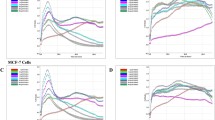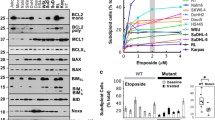Abstract
The wide variation in sensitivity of cancer cells to TRAIL- or histone deacetylase (HDAC) inhibitor — induced apoptosis precludes successful treatment of cancer with these agents. We report here that TRAIL and SBHA synergistically induce apoptosis of melanoma cells as revealed by quantitative analysis using the normalized isobologram method. This is supported by enhanced activation of caspase-3 and cleavage of its substrates, PARP and ICAD. Co-treatment with SBHA and TRAIL did not enhance formation of the death-inducing signaling complex (DISC) and processing of caspase-8 and Bid, but potentiated activation of Bax and release of Cytochrome C and Smac/DIABLO from mitochondria into the cytosol. SBHA down-regulated Bcl-XL, Mcl-1 and XIAP, but up-regulated Bax, Bak, and the BH3-only protein BimEL. Up-regulation of the latter by SBHA was attenuated by the presence of TRAIL, which was inhibitable by the pan-caspase inhibitor z-VAD-fmk. Inhibition of Bim by siRNA attenuated conformational changes of Bax, mitochondrial apoptotic events, and activation of caspase-3, leading to marked inhibition of the synergy between SBHA and TRAIL. Thus, Bim plays an essential role in synergistic induction of apoptosis by SBHA and TRAIL in melanoma.
Similar content being viewed by others
References
Nagata S (1997) Apoptosis by death factor. Cell 88:355–65
Walczak H, Krammer PH (2000) The CD95 (APO-1/Fas) and the TRAIL (APO-2L) apoptosis systems. Exp Cell Res 256:58–6
Walczak H, Miller RE, Ariail K et al (1999) Tumoricidal activity of tumor necrosis factor-related apoptosis-inducing ligand in vivo. Nat Med 5:157–63
Ashkenazi A, Pai RC, Fong S et al (1999) Safety and antitumor activity of recombinant soluble Apo2 ligand. J Clin Invest 104:155–62
Gliniak B, Le T (1999) Tumor necrosis factor-related apoptosis-inducing ligand’s antitumor activity in vivo is enhanced by the chemotherapeutic agent CPT-11. Cancer Res 59:6153–158
Hersey P, Zhang XD (2003) Overcoming resistance of cancer cells to apoptosis. J Cell Physiol 196:9–8
Hersey P, Zhang XD (2001) How melanoma cells evade trail-induced apoptosis. Nat Rev Cancer 1:142–0
Ashkenazi A, Dixit VM (1998) Death receptors: signaling and modulation. Science 281:1305–308
Green DR, Reed JC (1998) Mitochondria and apoptosis. Science 281:1309–312
Thornberry NA, Lazebnik Y (1998) Caspases: enemies within. Science 281:1312–316
Cryns V, Yuan J (1998) Proteases to die for. Genes Dev 12:1551–570
Zhang XD, Zhang XY, Gray CP, Nguyen T, Hersey P (2001) Tumor necrosis factor-related apoptosis-inducing ligand-induced apoptosis of human melanoma is regulated by Smac/DIABLO release from mitochondria. Cancer Res 61:7339–348
Adams JM, Cory S (1998) The Bcl-2 protein family: arbiters of cell survival. Science 281:1322–326
Shimizu S, Narita M, Tsujimoto Y (1999) Bcl-2 family proteins regulate the release of apoptogenic cytochrome c by the mitochondrial channel VDAC. Nature 399:483–87
Kuwana T, Bouchier-Hayes L, Chipuk JE et al (2005) BH3 domains of BH3-only proteins differentially regulate Bax-mediated mitochondrial membrane permeabilization both directly and indirectly. Mol Cell 17:525–35
Boyle GM, Martyn AC, Parsons PG (2005) Histone deacetylase inhibitors and malignant melanoma. Pigment Cell Res 18:160–66
Bandyopadhyay D, Mishra A, Medrano EE (2004) Overexpression of histone deacetylase 1 confers resistance to sodium butyrate-mediated apoptosis in melanoma cells through a p53-mediated pathway. Cancer Res 64:7706–710
Zhang XD, Gillespie SK, Borrow JM, Hersey P (2004) The histone deacetylase inhibitor suberic bishydroxamate regulates the expression of multiple apoptotic mediators and induces mitochondria-dependent apoptosis of melanoma cells. Mol Cancer Ther 3:425–35
Jenuwein T, Allis CD (2001) Translating the histone code. Science 293:1074–080
Grunstein M (1997) Histone acetylation in chromatin structure and transcription. Nature 389:349–52
Archer SY, Meng S, Shel A, Hodin RA (1998) p21(WAF1) is required for butyrate-mediated growth inhibition of human colon cancer cells. Proc Nalt Acad Sci USA 95:6791–796
Yoshida M, Kijima M, Akita M, Beppu T (1990) Potent and specific inhibition of mammalian histone deacetylase both in vivo and in vitro by trichostatin A. Biol Chem 265:17174–717
Sugita K, Koizumi K, Yoshida H (1992) Morphological reversion of sis-transformed NIH3T3 cells by trichostatin A. Cancer Res 52:168–72
Munster PN, Troso-Sandoval T, Rosen N, Rifkind R, Marks PA, Richon VM (2001) The histone deacetylase inhibitor suberoylanilide hydroxamic acid induces differentiation of human breast cancer cells. Cancer Res 61:8492–497
Guo F, Sigua C, Tao J et al (2004) Cotreatment with histone deacetylase inhibitor LAQ824 enhances Apo-2L/tumor necrosis factor-related apoptosis inducing ligand-induced death inducing signaling complex activity and apoptosis of human acute leukemia cells. Cancer Res 64:2580–589
Reginato MJ, Mills KR, Paulus JK et al (2003) Integrins and EGFR coordinately regulate the pro-apoptotic protein Bim to prevent anoikis. Nature Cell Biol 5:733–40
Zhang XD, Franco A, Myers K, Gray C, Nguyen T, Hersey P (1999) Relation of TNF-related apoptosis-inducing ligand (TRAIL) receptor and FLICE inhibitory protein expression to TRAIL-induced apoptosis of melanoma. Cancer Res 59:2747–753
Gross A, McDonnell JM, Korsmeyer SJ (1999) Bcl-2 family members and the mitochondria in apoptosis. Genes Dev 13:1899–911
Nechushtan A, Smith CL, Hsu YT, Youle RJ (1999) Conformation of the Bax C-terminus regulates subcellular location and cell death. EMBO J 18:2330–341
Desagher S, Osen-Sand A, Nichols A et al (1999) Bid-induced conformational change of Bax is responsible for mitochondrial cytochrome c release during apoptosis. J Cell Biol 144:891–01
Chen D, Zhou Q (2004) Caspase cleavage of BimEL triggers a positive feedback amplification of apoptotic signaling. Proc Natl Acad Sci USA 101:1235–240
Inoue S, MacFarlane M, Harper N, Wheat LM, Dyer MJ, Cohen GM (2004) Histone deacetylase inhibitors potentiate TNF-related apoptosis-inducing ligand (TRAIL)-induced apoptosis in lymphoid malignancies. Cell Death Differ 11 (2):S193–06
Fulda S, Jeremias I, Debatin KM (2004) Cooperation of betulinic acid and TRAIL to induce apoptosis in tumor cells. Oncogene 23:7611–620
Watanabe K, Okamoto K, Yonehara S (2005) Sensitization of osteosarcoma cells to death receptor-mediated apoptosis by HDAC inhibitors through downregulation of cellular FLIP. Cell Death Differ 12:10–8
Kim YH, Park JW, Lee JY, Kwon TK (2004) Sodium butyrate sensitizes TRAIL-mediated apoptosis by induction of transcription from the DR5 gene promoter through Sp1 sites in colon cancer cells. Carcinogenesis 25:1813–820
Nakata S, Yoshida T, Horinaka M, Shiraishi T, Wakada M, Sakai T (2004) Histone deacetylase inhibitors upregulate death receptor 5/TRAIL-R2 and sensitize apoptosis induced by TRAIL/APO2-L in human malignant tumor cells. Oncogene 23:6261–271
Griffith TS, Fialkov JM, Scott DL et al (2002) Induction and regulation of tumor necrosis factor-related apoptosis-inducing ligand/Apo-2 ligand-mediated apoptosis in renal cell carcinoma. Cancer Res 62:3093–099
Vanoosten RL, Moore JM, Karacay B, Griffith TS (2005) Histone deacetylase inhibitors modulate renal cell carcinoma sensitivity to TRAIL/Apo-2L-induced apoptosis by enhancing TRAIL-R2 expression. Cancer Biol Ther 4:1104–112
Vanoosten RL, Moore JM, Ludwig AT, Griffith TS (2005) Depsipeptide (FR901228) enhances the cytotoxic activity of TRAIL by redistributing TRAIL receptor to membrane lipid rafts. Mol Ther 11:542–52
Rosato RR, Almenara JA, Dai Y, Grant S (2003) Simultaneous activation of the intrinsic and extrinsic pathways by histone deacetylase (HDAC) inhibitors and tumor necrosis factor-related apoptosis-inducing ligand (TRAIL) synergistically induces mitochondrial damage and apoptosis in human leukemia cells. Mol Cancer Ther 2:1273–284
Aron JL, Parthun MR, Marcucci G et al (2003) Depsipeptide (FR901228) induces histone acetylation and inhibition of histone deacetylase in chronic lymphocytic leukemia cells concurrent with activation of caspase 8-mediated apoptosis and down-regulation of c-FLIP protein. Blood 102:652–58
Adams JM (2003) Ways of dying: multiple pathways to apoptosis. Genes Dev 17:2481–495
Green DR, Kroemer G (2004) The pathophysiology of mitochondrial cell death. Science 305:626–29
Chen L, Willis SN, Wei A et al (2005) Differential targeting of prosurvival Bcl-2 proteins by their BH3-only ligands allows complementary apoptotic function. Mol Cell 17:393–03
Scaffidi C, Fulda S, Srinivasan A et al (1998) Two CD95 (APO-1/Fas) signaling pathways. EMBO J 17:1675–687
Rudner J, Jendrossek V, Lauber K, Daniel PT, Wesselborg S, Belka C (2005) Type I and type II reactions in TRAIL-induced apoptosis–results from dose-response studies. Oncogene 24:130–40
Zhang XD, Gillespie SK, Borrow J, Hersey P (2003) The histone Deacetylase Inhibitor Suberic Bishydroxamate: A potential sensitizer of melanoma to TRAIL-induced apoptosis. BioChem Pharmacol 66:1537–545
Author information
Authors and Affiliations
Corresponding author
Additional information
This work was supported by the NSW State Cancer Council, the Melanoma and Skin Cancer Research Institute Sydney, the Hunter Melanoma Foundation, NSW, and the National Health and Medical Research Council, Australia. X.D. Zhang is a Cancer Institute NSW Fellow.
Rights and permissions
About this article
Cite this article
Gillespie, S., Borrow, J., Zhang, X.D. et al. Bim plays a crucial role in synergistic induction of apoptosis by the histone deacetylase inhibitor SBHA and TRAIL in melanoma cells. Apoptosis 11, 2251–2265 (2006). https://doi.org/10.1007/s10495-006-0283-6
Published:
Issue Date:
DOI: https://doi.org/10.1007/s10495-006-0283-6




